Larry P. Pedigo
Department of Entomology
Iowa State University
Ames, IA 50011
Without question, pest population assessment and decision making are among the most basic elements in any integrated pest management (IPM) program. In fact, these activities characterize state of the art approaches in pest technology and differentiate IPM from other strategies.
Forming the basis of assessment and decision making is bioeconomics, the study of the relationships between pest numbers, host responses to injury, and resultant economic losses (Pedigo 1996). The relationship of bioeconomics to other elements of an IPM system is shown in Figure 1.
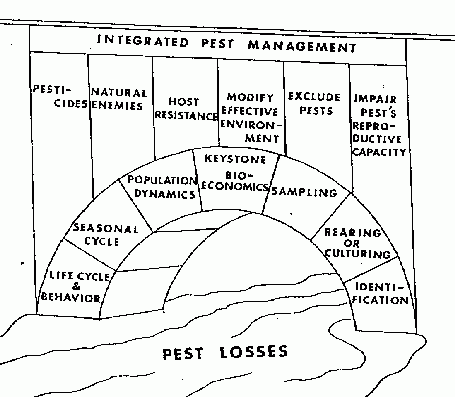
Here, it can be seen that bioeconomics is a keystone element, connecting basic biology and ecology on the one hand with sampling and identification on the other. It is an element that involves both biology and economics.
An important outcome of bioeconomics is the formation of decision rules that are used with management options. Of decision rules put forward, none has met with more success that those in the economic injury level (EIL) concept of Stern et al. (1959). In fact, this concept, with only minor changes, still forms the basis of most IPM programs in use today.
Therefore, this chapter will review some of the basic elements of EIL theory, consider the current status of bioeconomics research, and explore some of the traditional, as well as advanced, modes of economic threshold development. Additionally, some of the limitations involved in threshold development will be discussed as well as areas for future improvement.
Elements of Economic Injury Level Concept
The elements Stern et al. proposed formally in 1959 are essentially the same as those used today. They are economic damage, economic injury level, and economic threshold. Collectively, these elements form the EIL concept.
Economic damage
Economic damage is the most elementary of the EIL elements, being defined by Stern et al. as "the amount of injury which will justify the cost of artificial control measures." This definition has been criticized by several workers because a quantitative expression of economic justification was not given.
However, Southwood and Norton (1973) presented a practical mathematical expression that has been used widely. That expression is:
C(a) = Y[s(a)]xP[s(a)] - Y(s)xP(s)
where: Y = yield, P = price per unit of yield, s = level of pest injury, a = control action [s(a)]is level of injury as modified by the control action], and C = cost of the control action. This equation simply states that cost of the control tactic equals yield times price when the tactic is applied minus yield times price without the tactic. Consequently, economic damage begins at this point, i.e., when the cost of damage equals the cost of suppression.
Although not recognized by Stern et al., another useful damage level to consider is the damage boundary (Pedigo et al. 1986), also called the damage threshold. The The damage boundary is the lowest level of injury that can be measured (Figure 2). This level of injury occurs before economic loss. Expressed in terms of yield, economic loss is reached at the gain threshold, and the gain threshold is beyond the damage boundary. For high value commodities, the damage boundary may be very close to the gain threshold. A basic IPM principle ensues from the damage boundary/economic damage relationship; it is that no injury level below the damage boundary merits suppression, but injury predicted to result in economic damage does.
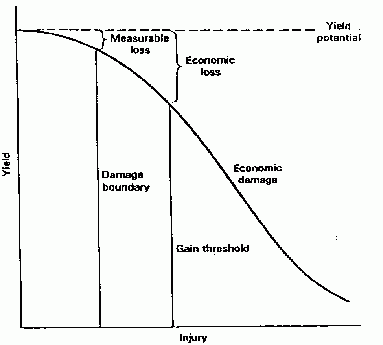
Economic Injury Level
Another of the basic elements, the economic injury level, was defined by Stern et al. as the lowest population density that will cause economic damage. The EIL is the most basic of the decision rules; it is a theoretical value that, if actually attained by a pest population, will result in economic damage. Therefore, the EIL is a measure against which we evaluate the destructive status and potential of a pest population.
Although the EIL is expressed as a pest density, it is actually a level of injury that is indexed by pest numbers. We use insect numbers for practicality, i.e., it is usually easier to count pests rather than to quantify and project future injury. The relationship of the EIL to the damage boundary is shown in Figure 3.
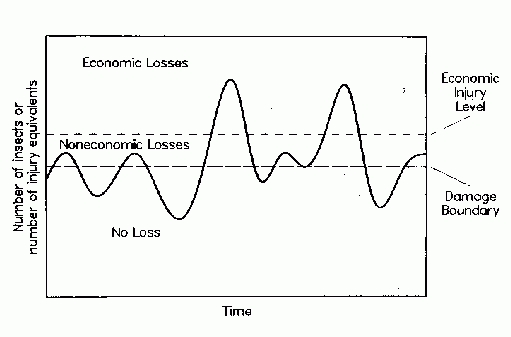
Because the EIL is actually a degree of injury, it is sometimes useful to think of it in terms of injury equivalents (Pedigo et al. 1986). An injury equivalent is the total injury produced by a single pest over an average lifetime. It is a potential value, i.e., a pest dying prematurely will obtain only a partial equivalent. The concept of using injury equivalents is particularly appropriate when working with populations having discrete generations and when trying to account for mortality and its effect on total injury. If numbers alone are used, the economic threshold may need to be positioned above the EIL early in a generation to account for subsequent mortality. When using injury equivalents, the economic threshold is always below the EIL, as presented in the Stern et al. model. Injury equivalents have also been used to develop EILs for complexes of insect pests with similar feeding behaviors (Hutchins et al. 1988).
Whether expressed as numbers or injury equivalents, the EIL is governed by five primary variables: cost of the management tactic per production unit, (C), market value per production unit (V), injury units per pest(I), damage per injury unit (D), and the proportional reduction in pest attack (K). If the relationship of these variables is linear or roughly so, the EIL can be given as:
EIL = C/VIDK
In instances where D is strongly curvilinear, it would be necessary to replace D with a complex function relating damage to total injury from a population (Pedigo et al 1986). Subsequently, the final decision rule, an objective ET, is based on this calculated value.
As represented by its variables, the EIL equation is a truly unifying principle of IPM. As such, the equation provides a basis for strategic decisions on IPM research priorities and for development of environmentally sustainable management systems.
Economic threshold
The economic threshold (ET) differs from the EIL in that it is a practical or operational rule, rather than a theoretical one. Stern et al. defined the ET as "the population density at which control action should be determined (initiated) to prevent an increasing pest population (injury) from reaching the economic injury level." Although measured in insect density, the ET is actually a time to take action, i.e., numbers are simply an index of that time. Some workers refer to the ET as the action threshold to emphasize the true meaning of the ET. The relationship of the ET to the EIL and action times is shown in Figure 4.
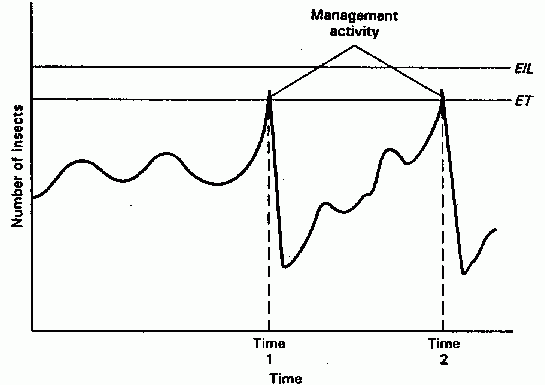
The ET is a complex value that depends on estimating and predicting several difficult parameters. The most significant of these include 1) the EIL variables (this is because the ET is based on the EIL), 2) pest and host phenology, 3) population growth and injury rates, and 4) time delays associated with the IPM tactics utilized. Because of the uncertainties involved, particularly in pest population growth rates, most ETs are relatively crude; they do not carry the same quantitative resolution as do EILs.
Kinds of Economic Thresholds
The ET of Stern et al. has been referred to as an operational, if not an ideal, decision rule (Mumford and Norton 1984), and it is the ultimate guideline that must be developed in any given situation. Yet, the ET is the most problematic because of considerable uncertainty.
In developing ETs, several approaches, representing different levels of sophistication, have been devised. The level of sophistication has been determined largely by existing data and needs of the particular management program. Most of these approaches can be grouped into two broad classes, subjective determinations and objective determinations.
Subjective vs. Objective ETs
Subjective determinations are the crudest approach to ET development. They are not based on a calculated EIL; rather, they are based on a practitioner's experience. These have been called nominal thresholds by Poston et al. (1983) and are not formulated from objective criteria. Nominal thresholds probably represent the majority of ETs found in extension publications and verbal recommendations. Although static and possibly inaccurate, these still are more progressive than using no ET at all because they require pest population assessment. Therefore, their use can often result in reduced pesticide applications.
Objective ETs, on the other hand, are based on calculated EILs, and they change with changes in the primary variables of the EILs (e.g., market values and management costs). With objective ETs, a current EIL is calculated, and estimates are made regarding potential of the pest population to exceed the EIL. The final decision on action to be taken and timing is based on expected increases in injury and logistical delays, as well as activity rates of the tactics used. Considering the various types of objective ETs, at least three can be described. These types can be termed 1) fixed ETs, 2) descriptive ETs, and 3) dichotomous ETs.
Fixed ETs
The fixed ET is the most common type of objective ET. With this type, the ET is set at a fixed percentage of the EIL, e.g., 50% or 75%. Use of the term "fixed" does not mean that these are unchanging; it means only that the percentage of the EIL is fixed. Therefore, these change constantly with changes in the EIL. The fixed ET ignores differences in population growth and injury rates; however, the percentages are usually set conservatively low; i.e., when they err, they err on the side of taking action when it is not necessary. Fixed ETs are crude, but they may be the highest level that can be developed when pest population dynamics is poorly understood. There are many examples of fixed ETs for crops, including those for pests on grapes, beans, soybean, sorghum, rice, and apples (Pedigo et al. 1986).
Descriptive ETs
Descriptive ETs are more sophisticated than fixed ETs. With descriptive ETs, a description of population growth is made, and need for, as well as timing of, action is based on expected future growth in injury rates. As an example, the green cloverworm, Plathypena scabra (F.), be sampled in soybean beginning in late June and an early growth curve established (Figure 5). When larval numbers cause injury to reach the damage boundary, a statistical model based on sampling data can be applied to project future population growth. If these projections indicate that numbers will exceed the EIL during the susceptible period, then action is taken; if not, incremental sampling usually would be continued to detect any unexpected population changes until the crop is no longer susceptible. This approach has the advantage of using current sampling data to keep track of the injuriousness of the pest population. Its weakness is in making projections from earlier injury rates; i.e., future rates may not show a strong relationship to past rates, giving errors in decision making.
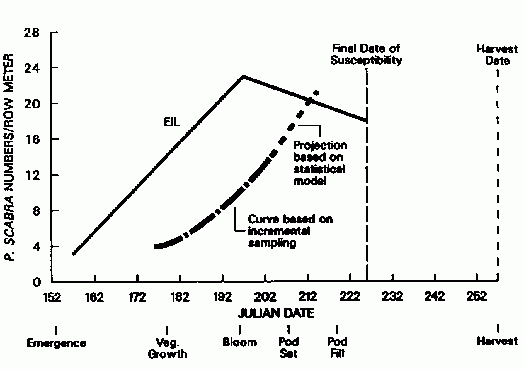
Dichotomous ETs
Dichotomous ETs can be developed by using a statistical procedure for classifying a pest population as economic or noneconomic from samples taken over time. The statistical procedure has been termed timesequential sampling, which can be used with the damaging stage of a pest to objectively determine its ET. The procedure is based on the sequential probability ratio test as is conventional or spatial sequential sampling. However, timesequential sampling differs in that a time perspective, rather than a space perspective, is used to make decisions. For more information on this approach see Pedigo and Buntin (1994).
Economic Injury Level Concepts and Environmental Quality
Previously, the use of objective ETs has had an important impact on environmental quality, particularly in certain crops where it is the basis for IPM (National Research Council 1989). Regular application of conventional ETs can result in reduced pesticide use by decreasing the frequency of application. Indeed, it has been estimated that pest monitoring, establishment of EILs, and reduced pesticide dosage can reduce pesticide use by 30 to 50%. Therefore, an expanded use of objective ETs can be considered an important tactic in conserving environmental quality However, aside from development and increased use of exiting ETs, an examination of the EIL concept itself also can lead to even further reductions in pesticide use.
Concept of Environmental EILs
The challenge of providing IPM recommendations to result in ever decreasing pesticide inputs while maintaining agricultural production and profitability is daunting. In most instances the call is made for alternative tactics that replace pesticides. Currently, particular emphasis is being placed on developing safe and profitable biological control tactics or biointensive IPM (i.e., nonchemical IPM). Important as this priority may be, there are locations, systems, and circumstances where alternative tactics are unlikely to be practical even in the distant future. Some of the situations where development of alternatives has lagged are for annual crops, sporadic pest outbreaks, and pests in northern climates, i.e., agricultural situations that comprise most of the staple commodities and their related arthropod pests.
Further decreases in pesticide inputs in these situations can and should be attempted by developing environmentally based EILs and their concomitant ETs. An Environmental EIL is an EIL that focuses on environmental issues and attempts to incorporate environmentally conscience actions in its makeup, i.e., a purposeful manipulation of the EIL variables. Activities to support greater environmental responsiveness in the EIL include accounting for environmental costs in the C variable, reducing damage per injury by increasing plant tolerance in the D variable, and developing an effective, yet environmentally responsible, K variable by reducing pesticide application rates. For detailed information on suggested manipulations of the EIL variables see Pedigo and Higley (1992).
Limitations of the EIL Concept and Future Outlook
Many factors have limited both the design of new economic thresholds and the development of existing ones. Some of the major limitations are:
- Lack of a thorough mathematical definition of the ET
- Lack of valid EILs
- Inability to make cost effective and accurate population estimates
- Inability to predict critical ET variables such as market values and population trends
- Lack of a simple means to incorporate externalities, especially environmental costs into EILs
Future development and improvement of economic thresholds in IPM requires that these existing limitations be addressed and overcome where possible. To advance, the limitations should be addressed across all areas, including theoretical work, research, and implementation. In particular, research is needed to achieve improved thresholds. Here, knowledge of pest population dynamics and a better capability to predict pest population trends is needed. Additionally, more research should be directed toward improving knowledge of pest injury and host responses to injury; an understanding of this important area is still quite inadequate. Indeed, knowledge gained about host responses to injury will greatly improve EILs and accompanying ETs. In particular, improved ETs can produce practical management solutions at a time when agriculture is seeking increased production efficiencies and sustainable yields.
References Cited
- Pedigo, L. P. 1996. Entomology and Pest Management. Second Edition. 1996. Prentice-Hall Pub., Englewood Cliffs, NJ. 679 pp.
- Pedigo, L. P., and L. G. Higley. 1992. A new perspective of the economic injury level concept and environmental quality. American Entomologist, 38:1221.
- Pedigo, L. P., and G. D. Buntin (Eds.). 1994. Handbook of Sampling Methods for Arthropods in Agriculture. CRC Press, Boca Raton, FL. 616 pp.
- Pedigo, L. P., S. H. Hutchins, and L. G. Higley. 1986. Economic injury levels in theory and practice. Annu. Rev. Entomol. 31:341368.
- Poston, F. L., L. P. Pedigo, and S. M. Welch. 1983. Economic injury levels: reality and practicality. Bull. Entomol. Soc. Am. 29:4953.
- Southwood, T. R. E., and G. A. Norton. 1973. Economic aspects of pest management strategies and decisions. Ecol. Soc. Aust., Mem. 1:168184.
- Stern, V. M., R. F. Smith, R. van den Bosch, and K. S. Hagen. 1959. The integrated control concept. Hilgardia 29:81101.